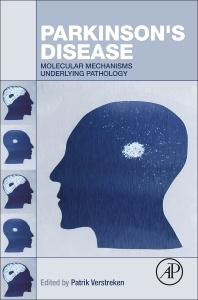Parkinson's Disease Molecular Mechanisms Underlying Pathology
Coordonnateur : Verstreken Patrik

Parkinson?s Disease: Molecular Mechanisms Underlying Pathology explores the molecular pathways at the basis of the cellular defects connected to Parkinson?s disease, the second most common neurodegenerative disease, and the most common movement disorder. This book presents the latest research on the pathways and mechanisms that have been discovered to play a role in Parkinson's pathology.
This focus on mechanisms rather than individual genes allows the contributors to elaborate on overlapping and joint functions of different causative genes. Readers will find descriptions of model systems that present parallels (and differences) between discoveries in different species, demonstrating the importance of multidisciplinary research that spans a broad array of technologies and model organisms.
Written from both a cross-methodology and cross-species perspective, the book provides readers with the current state of knowledge on the molecular biology of Parkinson?s.
1. The Neurogenetics of Parkinson’s Disease and putative links to other neurodegenerative disorders Christina M. Lill and Christine Klein 2. Electron transport chain Liesbeth Aerts and Vanessa A. Morais 3. Mitochondrial fission and fusion Victoria L. Hewitt and Alexander J. Whitworth 4. Axonal mitochondrial transport Evgeny Shlevkov and Thomas L. Schwarz 5. Mitophagy Louise King and Hélène Plun-Favreau 6. Autophagy and vesicle trafficking Patrick Lewis, Maria Perez-Carrion and Giovanni Piccoli 7. Endocytosis and synaptic function Sandra Soukup, Patrik Verstreken and Sven Vilain 8. Neuroinflammation as a potential mechanism underlying Parkinson’s Disease Carolina Cebrián and David Sulzer 9. Protein translation in Parkinson’s Disease Jungwoo Wren Kim, Leire Abalde-Atristain, Jia Hao, Ian Martin, Valina L. Dawson and Ted M. Dawson
Neuroscientists, grad students in biological and biomedical sciences, postdocs, academic/biotech researchers
- Written by experts in the field that focus on pathways and mechanisms implicated in Parkinson’s pathology
- Draws parallels between multidisciplinary discoveries in different model organisms using an array of technologies
- Provides a cross-methodology and cross-species approach to understanding the molecular biology of Parkinson’s disease
- Includes approximately 25 color Illustrations and diagrams to explain concepts and models
- Focuses on key pathways and mechanisms (as opposed to model organism or gene) to provide a multidisciplinary approach to Parkinson’s disease
Date de parution : 01-2017
Ouvrage de 330 p.
15x22.8 cm
Épuisé



